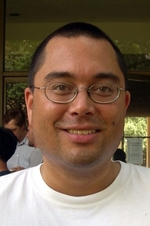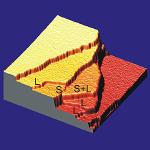This week’s Rice science lesson comes from (of all places) the math department.
Specifically it’s from associate professor David Damanik (he’s a graduate of Goethe U. in Frankfurt, Germany) and it’s about something called quasicrystals.
Quasicrystals are no older than Buckyballs, really. As the name implies, their structure is midway between a crystal and a lump o’ stuff. Dan Schachtman of the NIST found the first one, in 1982, through x-ray diffraction. An alloy he’d made was stable, but it had a five-sided diffraction pattern, like a pentagon.
Impossible, the scientists said. Until they made more. Dozens more, actually. And the normal equation for figuring out the properties of a crystalline structure, the Schrödinger operator, didn’t work. There was no way to tell how electrons would behave in such a structure, and thus what the properties of any quasicrystal might be.
(This happy little quasicrystal lives at Omnicron, not an ad agency but a nanotechnology outfit in Germany.)
Until now. Damanik worked with Serguei Tcheremchantsev,
who works at the University of Orleans in France on a mathematical
proof of how the electrons will behave in this new structure. Which
means we can design quasicrystals with predictable properties, and
actually get some use out of them, rather than have them sit on our
desks and hold down papers.
All will be revealed in the July issue of the Journal of the American Mathematical Society. Sorry, no pictures. It’s not how they roll.
And now that we know how to predict what these little guys will do, maybe we can enlist some of them in the War Against Oil.












Some corrections:
It’s Dan Schechtman, not Schactman
The company is Omicron, not Omnicron
The diffraction pattern was ten-sided like a decagon, not five-sided like a pentagon.
Some corrections:
It’s Dan Schechtman, not Schactman
The company is Omicron, not Omnicron
The diffraction pattern was ten-sided like a decagon, not five-sided like a pentagon.